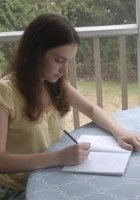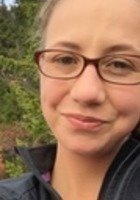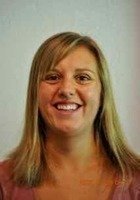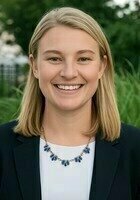Award-Winning Tutors
serving Beverly, MA
Who needs tutoring?
FEATURED BY
TUTORS FROM
- YaleUniversity
- PrincetonUniversity
- StanfordUniversity
- CornellUniversity
Award-Winning Tutors serving Beverly, MA

Jacqueline
I'm creative, open-minded, and detail-oriented. I like finding ways to make curriculum interesting and engaging. I have experience as a subject tutor, peer writing tutor, and classroom leader. I grew up with a learning disorder/disability, so I am empathetic to students who struggle to fit the academic mold.
Education & Certifications

Amanda
I am devoted to personal connections and making each student realize their potential. I love to bring positivity and optimism to most situations I encounter, and am great at on-the-spot troubleshooting. I thrive off of relationships and feeding off the energy the universe provides for us all!
Education & Certifications

Dorothy
I'm always interested in the connections between organisms, other organisms and the abiotic environment. I'm also interested in how humans interact with the non-human environment, especially in caring for ecosystems, protecting ecosystem services, transitioning to a carbon neutral economy, and ethics surrounding these issues. I care about students, particularly high-school and college aged students in the climate generation, and hope to equip my students with the knowledge and tools they need to...
Education & Certifications

Sean
I am an undergraduate student, attending Bryant University. I Major in Communication, and I double Minor in Literary / Cultural Studies, and Business Managment. My goal is to attend graduate School, and to earn a MA in Humanities with a concentration in Classical Education. It would be my pleasure to tutor students in Ethics, British Literature, Philosophy, Political Science, Cultural Studies, and the like.
Education & Certifications

Zach
I am fascinated by language, by both the intricacies of its structure and by the awesome array of possibilities it can unleash when masterfully used. Give me a piece of writing, whether highly technical or enchantingly lyrical, and I will immerse myself in it and then quickly become “fluent” in its particular style.
Education & Certifications
SAT SCORES
Verbal: 710

Matthew
I am a graduate of the University Massachusetts Amherst. I received my Bachelor of Arts in Economics and graduated with high honors in my major. Since graduation, I have been working as a property manager for the Dolben Company. I work and communicate with people of all ages, demographics and education levels every single day.
Education & Certifications
University
Bachelor's
Sheridan
I am a graduate from University of Maryland Baltimore County (UMBC) with a degree in Biology. I am currently pursuing my Doctoral of Dental Medicine degree from Harvard School of Dental Medicine (HSDM). During my time at UMBC, I served as a teaching assistant in chemistry and biology classes ranging from introductory biology to more advanced courses that I had previously taken. I also served as a tutor in my time at UMBC a wide variety of subjects in the science categories. In my time at HSDM, I...
Education & Certifications

Sarah
I am a graduate student at the Harvard School of Public Health living, working, and studying in Boston, MA. I have a passion for people and for learning. Specifically, I have studied Spanish for ten years, and graduated from Bucknell University with a degree in Spanish in 2014. I have served as a teaching assistant for a class of ESL kindergarteners and have lived abroad in Costa Rica and Mexico. I am comfortable with students of all ages and ability levels in Spanish, and also available for ESL...
Education & Certifications

Sarah
I am a graduate of the University of Virginia, where I received a Bachelor of Arts degree in Global Public Health. After college, I went on to get my Masters of Science in Biomedical Science at Tufts University School of Medicine. I am currently applying to medical school and hope to matriculate next fall. In the past, I have tutored middle school geometry and worked as a peer tutor in a college level introductory biology lab. I have an extensive background in biology and am passionate about hea...
Education & Certifications
ACT SCORES
Composite: 31
English: 32
Math: 31
Browse Tutors in Top Massachusetts Cities
- Boston Tutors
- Springfield Tutors
- Worcester Tutors
- Barnstable Tutors
- New Bedford Tutors
- Leominster Tutors
- Cambridge Tutors
- Lowell Tutors
- Brockton Tutors
- Quincy Tutors
- Lynn Tutors
- Fall River Tutors
- Newton Tutors
- Somerville Tutors
- Lawrence Tutors
- Framingham Tutors
- Haverhill Tutors
- Waltham Tutors
- Malden Tutors
- Weymouth Tutors
Top Subjects in Beverly, MA
- SAT Tutors
- Japanese Tutors
- AP Calculus AB Tutors
- Executive Functioning Tutors
- Orton Gillingham Tutors
- ACT Tutors
- Conversational Spanish Tutors
- MCAT Tutors
- GRE Tutors
- LSAT Tutors
- SAT Math Tutors
- Organic Chemistry Tutors
- Elementary School Reading Tutors
- Calculus Tutors
- Algebra Tutors
- High School Chemistry Tutors
- Pre-Calculus Tutors
- Middle School Math Tutors
- Geometry Tutors
- Elementary School Math Tutors
Connect with Beverly Tutors
Get matched with local expert tutors
